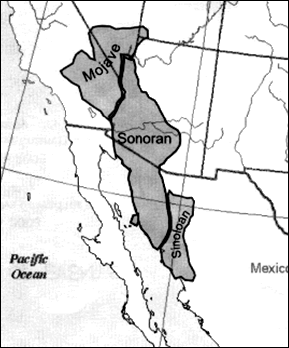 |
Figure 1: Range of the desert tortoise. Image courtesy Zach Cava.
|
Occupying the Sonoran and Mojave deserts in parts of California, Nevada, Arizona, Utah, and Mexico, the desert tortoise (Gopherus agassizii) relies on its ability to dig burrows to survive in this extreme climate. This is possible thanks to digging claws on the turtle’s front feet, allowing underground hibernation in the winter and estivation during the summer heat (1). The tortoise can reach up to 15 inches in length and appears grey or brown on its top (carapace) and yellow on its underside (plastron), with scaled, protective skin (2). Males battle for mates by trying to flip one another over and once a competitor has success, he may court a female. Clutches of usually 4-7 eggs are laid in burrows and buried to incubate for 90-120 days (2). The resulting offspring grow very slowly, have a soft shell making them vulnerable to predators, and have low chances of survival. The diet of these hardy creatures consists of available leafy plants and flowers, which can allow selectivity in wet years and rare consumption of food in dry years (2).
 |
Figure 2: A desert tortoise in a defensive position. Note the long claws used for digging burrows. Photo courtesy Jeff Ahrens.
|
Since its recognition as a threatened species in 1973, the population has seen a significant decrease while the geographic habitat has remained fairly constant. At monitored Mojave desert cites losses of 33% to 77% were recorded in 1980s (2). The Mojave population of the desert tortoise was added as an emergency listing in 1989, making the collection individuals a federal offense (2). In 2008 a petition was filed to list the Sonoran population under the Endangered Species Act (2).
 |
Figure 3: An adult desert tortoise inside of its burrow. Photo courtesy Zach Cava.
|
Urban development promotes the growth of populations of predators including ravens and coyotes which prey on juvenile tortoises, resulting in a survival rate of about 5% during the first few years of life (3). Development also creates linear barriers in the form of roads causing direct mortality of tortoises from human contact and promotes the spreading of weedy plant species that can increase the risk of wildfire. Increased growth of agriculture near the Colorado River contributes to habitat destruction, as well as mining operations and other human activity. Growing populations of grazing livestock outcompete tortoises for what little vegetation there is after rainfall, resulting in, “the general decline in abundance and species diversity in annual and perennial forbs that occurs over time in grazed areas” (3). These large mammals can also resulting in the degradation of soil quality and destruction of tortoise burrows.
 |
Figure 4: A man’s hand extended beside a juvenile desert tortoise, showing its vulnerable size. Photo courtesy Brad Chapman.
|
Actions for the recovery of the desert tortoise include publishing a new revised recovery plan, as well as working to better understand all of its threats in order to reduce them and then monitor the effects over a five year period. Currently mitigating the impact of grazing livestock, mining, and predators have been recognized in the recovery plan as most urgent. As this is being done, it a key priority to record the populations, threats, and how they are locally managed in order to revise the recovery plan along the way, ensuring that goals stay relevant. Keeping these records will allow for a set of guidelines to be established for how to reduce threats, restore local populations, and content to collect useful data to learn more about which efforts may lead to successful recovery. In order to implement all of these goals another priority has become the renovation of the Desert Tortoise Conservation Center, so that it may, “function as a center for scientific research, training, and education” (4). All of this framework has put in place so that this unique species, the desert tortoise, can continue to survive its harsh desert home.
By: Cory Hughes
Works Cited
1. Desert Tortoise (Gopherus agassizii). Pima Community College Desert Ecology of Tucson, AZ. n.d. Web. 6 Mar. 2015.
2. Desert Tortoise, Gopherus agassizii. 2 Global, 2010. Web. 6 Mar. 2015.
3. Mojave Desert Tortoise (Gopherus agassizii) Sonoran Desert Tortoise (Gopherus morafkai). 3 of Land Management, n.d. Web. 6 Mar. 2015.
4. U.S. Fish and Wildlife Service Spotlight Species 5-Year Action Plan (2010-2014). U.S. Fish and Wildlife Service. 2009. Web. 6 Mar. 2015.
No comments:
Post a Comment